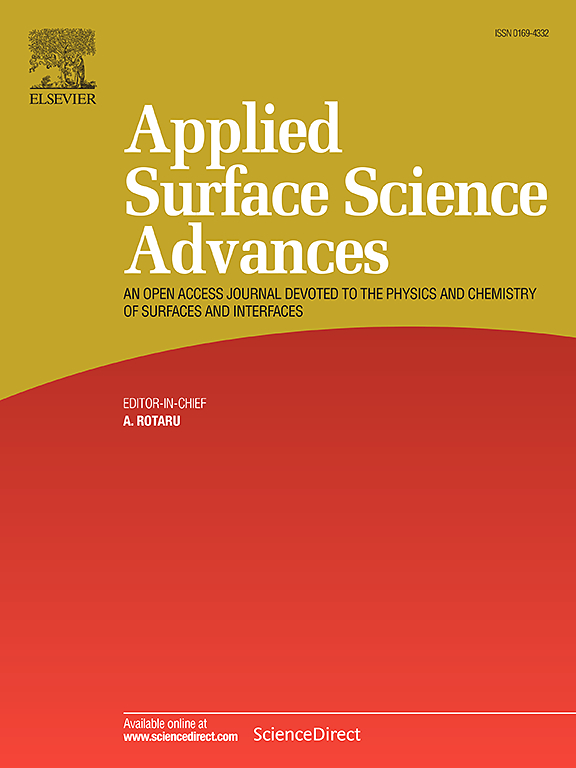Mitigating electrical degradation in ultra-thin IGZO TFTs through contact engineering with Al2O3 interlayer
IF 8.7
Q1 CHEMISTRY, PHYSICAL
引用次数: 0
Abstract
This study proposes an effective solution to mitigate performance degradation in ultra-thin devices after systematically investigating how the channel thickness affects the electrical characteristics of amorphous indium gallium zinc oxide (a-IGZO) thin-film transistors (TFTs). When the channel thickness is reduced below 5 nm, a significant decrease in mobility and current crowding are observed. This degradation primarily stems from Ti-induced oxidation and trap formation, which are not confined to the interface but extend into the IGZO channel bulk, physically damaging the electron conduction path and ultimately reducing the field-effect mobility to approximately 0.2 cm²/V·s. To address this issue, an atomic-layer-deposited (ALD) Al₂O₃ interlayer (IL) was introduced at the Ti/IGZO interface. Although the TMA precursor used in ALD has strong reactivity with IGZO components, the self-limiting surface reaction characteristic of ALD confines chemical interactions to the IGZO surface, thereby forming a uniform and dense dielectric film without damaging the underlying channel. Additionally, the resulting Al₂O₃ layer acts as a thermodynamically stable diffusion barrier that prevents spontaneous redox reactions with Ti, effectively suppressing the formation of interfacial oxides. As a result, the Al₂O₃ IL preserves the chemical and structural integrity of the IGZO channel and enables robust electron injection at the contact interface. Notably, with a 3 nm-thick IL, the field-effect mobility of ultra-thin 3 nm IGZO TFTs was significantly enhanced from ∼0.2 to ∼2.4 cm²/V·s. This study highlights the importance of interfacial engineering in addressing contact resistance issues in ultra-thin oxide semiconductors and provides a scalable and effective strategy for developing high-performance IGZO-based TFTs for next-generation electronic applications.
通过Al2O3夹层接触工程减轻超薄IGZO tft中的电退化
本研究在系统地研究了沟道厚度如何影响非晶铟镓锌氧化物(a-IGZO)薄膜晶体管(TFTs)的电学特性后,提出了一种有效的解决方案来缓解超薄器件的性能下降。当通道厚度减小到5nm以下时,可以观察到迁移率和电流拥挤度的显著降低。这种降解主要源于ti诱导的氧化和陷阱形成,它们不仅局限于界面,而且延伸到IGZO通道体中,物理破坏了电子传导路径,最终将场效应迁移率降低到约0.2 cm²/V·s。为了解决这个问题,在Ti/IGZO界面上引入了原子层沉积(ALD) Al₂O₃夹层(IL)。虽然ALD中使用的TMA前驱体与IGZO组分具有很强的反应活性,但ALD的自限制表面反应特性将化学相互作用限制在IGZO表面,从而形成均匀致密的介电膜,而不会损坏底层通道。此外,生成的Al₂O₃层作为一个热力学稳定的扩散屏障,阻止了与Ti的自发氧化还原反应,有效地抑制了界面氧化物的形成。因此,Al₂O₃IL保留了IGZO通道的化学和结构完整性,并在接触界面上实现了强大的电子注入。值得注意的是,在3nm厚的IL下,超薄3nm IGZO tft的场效应迁移率从~ 0.2 cm²/V·s显著提高到~ 2.4 cm²/V·s。该研究强调了界面工程在解决超薄氧化物半导体接触电阻问题中的重要性,并为开发下一代电子应用的高性能基于igzo的tft提供了可扩展和有效的策略。
本文章由计算机程序翻译,如有差异,请以英文原文为准。
求助全文
约1分钟内获得全文
求助全文

 求助内容:
求助内容: 应助结果提醒方式:
应助结果提醒方式:


